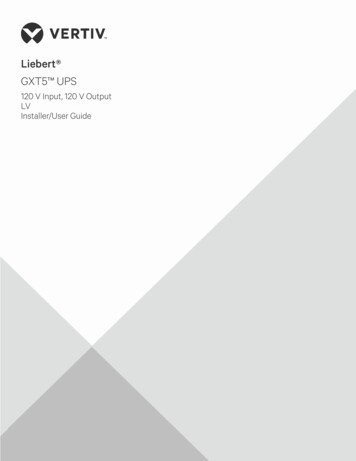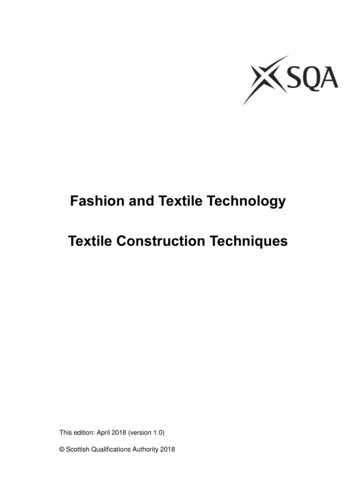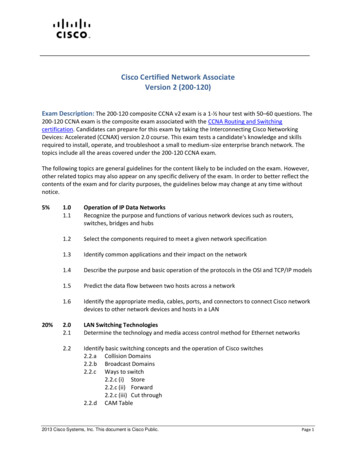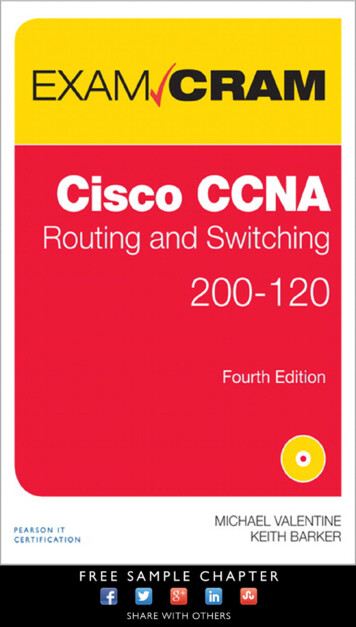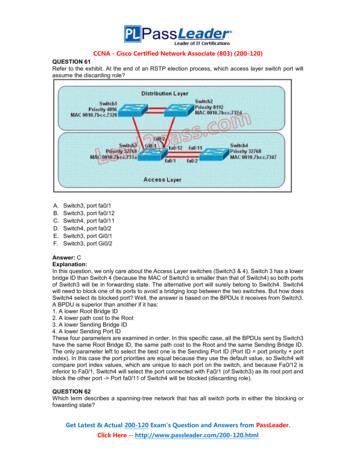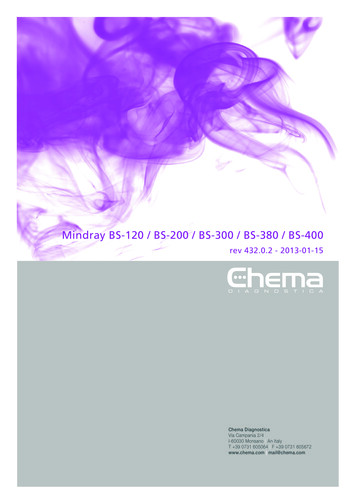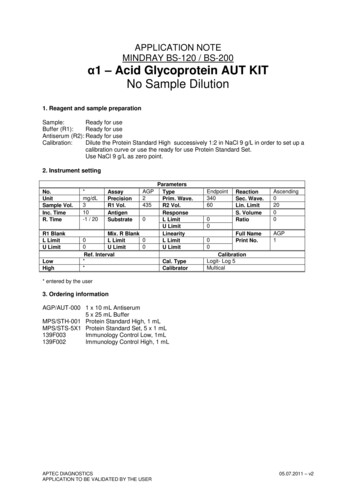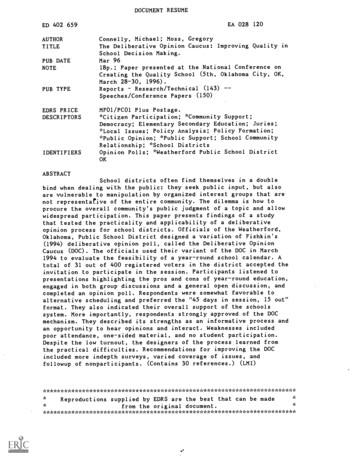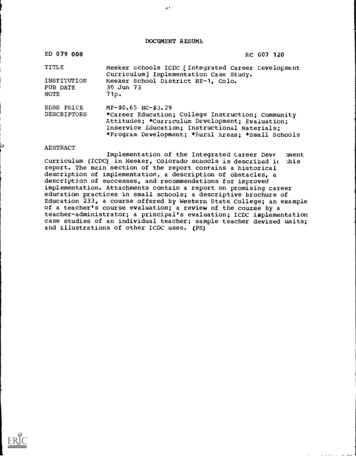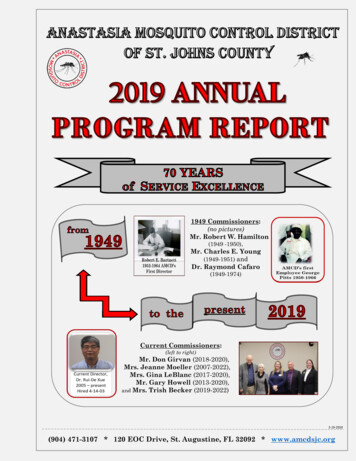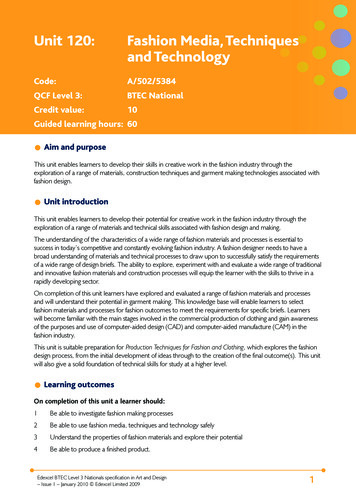
Transcription
Unit 120:Fashion Media, Techniquesand TechnologyCode:A/502/5384QCF Level 3:BTEC NationalCredit value:10Guided learning hours: 60Aim and purposeThis unit enables learners to develop their skills in creative work in the fashion industry through theexploration of a range of materials, construction techniques and garment making technologies associated withfashion design.Unit introductionThis unit enables learners to develop their potential for creative work in the fashion industry through theexploration of a range of materials and technical skills associated with fashion design and making.The understanding of the characteristics of a wide range of fashion materials and processes is essential tosuccess in today’s competitive and constantly evolving fashion industry. A fashion designer needs to have abroad understanding of materials and technical processes to draw upon to successfully satisfy the requirementsof a wide range of design briefs. The ability to explore, experiment with and evaluate a wide range of traditionaland innovative fashion materials and construction processes will equip the learner with the skills to thrive in arapidly developing sector.On completion of this unit learners have explored and evaluated a range of fashion materials and processesand will understand their potential in garment making. This knowledge base will enable learners to selectfashion materials and processes for fashion outcomes to meet the requirements for specific briefs. Learnerswill become familiar with the main stages involved in the commercial production of clothing and gain awarenessof the purposes and use of computer-aided design (CAD) and computer-aided manufacture (CAM) in thefashion industry.This unit is suitable preparation for Production Techniques for Fashion and Clothing, which explores the fashiondesign process, from the initial development of ideas through to the creation of the final outcome(s). This unitwill also give a solid foundation of technical skills for study at a higher level.Learning outcomesOn completion of this unit a learner should:1Be able to investigate fashion making processes2Be able to use fashion media, techniques and technology safely3Understand the properties of fashion materials and explore their potential4Be able to produce a finished product.Edexcel BTEC Level 3 Nationals specification in Art and Design– Issue 1 – January 2010 Edexcel Limited 20091
Unit content1 Be able to investigate fashion making processesBasic pattern-cutting: design a pattern; pattern layout; make a pattern eg using blocks, draping, modellingon the stand (bodice, skirt, trouser blocks, slashing, pivoting of darts, dart manipulation); features egnecklines, sleeves, collars; altering patterns; drawing out; cutting of full-size pattern pieces; specificgarments; identifying features eg darts, seams, facings, pockets, grain markings; care and storage ofpatternsGarment construction techniques: sewing samples eg pattern pieces, material, economy, cutting for style,design; components (identify, mark); interfacings; pinning; tacking; seaming; fitting eg altering patterns,sleeves, darts, pleats, gathersGarment finishing methods: seam finishes; facings; other finishes eg binding, hemming, lining; fasteningseg buttonholes and buttons, zippers, ties, rouleaux loops, Velcro, lacing, buckles, poppers, hooks, eyes;pressing methods; pressing characteristics of fabricsFunctions and use of hand tools: scissors; shears; pattern-cutting equipment eg tracing wheel, tracing paper,pattern master (junior and full size), pattern-cutting curve, set square, notchers, awl; pins and needlesFunctions and use of power tools: sewing machines eg domestic, industrial; pressing and steamingequipmentComputer-aided design (CAD) and computer-aided manufacture (CAM): application eg software, designprogrammes2 Be able to use fashion media, techniques and technology safelyHealth and safety: Health and Safety at Work Act (1974) elimination of risk to self and others; Controlof Substances Hazardous to Health (COSHH) Regulations (2002); tools; materials; processes; equipment;Personal Protective Equipment at Work Regulations (1992); personal protective equipment; Provision andUse of Work Equipment Regulations (1998); faults eg tools, equipment, corrective actionWorkshop practice: safe workshop practice; compliance with risk assessments; studio rules eg work area,hygiene, waste, obstruction, cleanliness, equipment; waste disposal3 Understand the properties of fashion materials and explore their potentialMaterials: natural; synthetic; combinations; other fabrics eg natural and simulated hides, skins, non-wovenand knitted fabrics; interlinings; fastenings; trimmingsProperties: eg drape, elasticity, insulation, strength, wash abilityCharacteristics: eg texture, feel, weave, sheen, density, thickness, transparency; sewing and pressingcharacteristicsFeatures: grain; warp; nap; pile; patternPotential: fabric characteristics; design requirements eg outerwear, daywear, formal, informal, sports wear,performance wear, occasion dressing; adults; children2Edexcel BTEC Level 3 Nationals specification in Art and Design– Issue 1 – January 2010 Edexcel Limited 2009
4 Be able to produce a finished productAssemble: create eg produce, demonstrate, make up (samples, swatches, test pieces, final product); issueseg problems, points,, impact, final production; specifications eg garment pieces, sewing techniquesProduce: potential; limitations fitness for purpose; finish; aesthetic qualities eg fashion fabrics, garments;sewing methods; needle size; stitch variations; trial samples; process eg seams, fabrics final garments;record eg annotated worksheets, note books, sketchbooks, design sheetsPresent outcomes presentation planning: eg methods, demonstration, digital, worksheets, designdevelopments, finished product, individual item, collection; format eg static display, fashion show, onscreen; target audienceEdexcel BTEC Level 3 Nationals specification in Art and Design– Issue 1 – January 2010 Edexcel Limited 20093
Assessment and grading criteriaIn order to pass this unit, the evidence that the learner presents for assessment needs to demonstrate thatthey can meet all the learning outcomes for the unit. The assessment criteria for a pass grade describe thelevel of achievement required to pass this unit.Assessment and grading criteriaTo achieve a pass grade theevidence must show that thelearner is able to:To achieve a merit grade theevidence must show that, inaddition to the pass criteria,the learner is able to:To achieve a distinction gradethe evidence must show that,in addition to the pass andmerit criteria, the learner isable to:P1investigate fashion makingprocesses[CT]M1 use fashion processesin a controlled andpurposeful way, comparingthe characteristics andproperties of diverse fashionmaking processesD1P2use fashion media, techniques M2 demonstrate experimentaland technology safelyand effective use of fashion[RL, TW, SM, EP]media, materials andprocesses in presentingfinished product.P3review the properties offashion materials againstdesign requirements[RL, TW, EP]P4produce a finished product.[IE, RL]independently and creativelydevelop an innovativefashion media, materials andtechnology product towardsproducing an exciting andoriginal presentation.PLTS: This summary references where applicable, in the square brackets, the elements of the personal,learning and thinking skills applicable in the pass criteria. It identifies opportunities for learners to demonstrateeffective application of the referenced elements of the skills.Key4IE – independent enquirersRL – reflective learnersSM – self-managersCT – creative thinkersTW – team workersEP – effective participatorsEdexcel BTEC Level 3 Nationals specification in Art and Design– Issue 1 – January 2010 Edexcel Limited 2009
Essential guidance for tutorsDeliveryA major focus of this unit is to equip learners with sufficient skills to interpret and carry through their designideas into a toile or finished garment.Learning outcome 1 requires that learners can investigate fashion making processes, including designing andmaking patterns. Learners can be taught pattern-cutting from blocks or drape modelling on stands. Ideallylearners who are taught drape modelling should also make a simple paper pattern from a block. Learnerswill need to understand how to alter patterns to fit different body shapes.Learning outcome 1 also requires learners to be taught how to sew by hand and machine and understandhow to decide on suitable fabric use. Learners will need to be taught to recognise the qualities of the traditionalskills associated with garment construction and fitting methods, fastening, finishing and embellishing. Theseskills will provide a sound basis for self-directed study in response to design briefs. Additionally, learners shouldbe made aware of the use and potential of CAD and CAM in the fashion industry. This may take the form ofa taught session or an industrial visit.For learning outcome 2 the health and safety issues relating to workshop practice must be stressed. Learnerswill need to be advised of, and adhere to, all aspects of current legislation associated with health and safetypractices in the studio or workplace. Learners should be encouraged to make a risk assessment of theirworkshop or studio. The appropriate COSHH guidance should be covered.For learning outcome 3, learners should gain an understanding of the properties and sewing characteristicsof a variety of fashion materials. This understanding may be delivered as a series of taught exercises. Learnerswill need to evaluate the properties of a variety of fashion materials and be able to recommend fabrics fordifferent fashion wear. They should also be able to comment on the quality of the finished garments. Thematerials explored could focus on one particular group of fabrics, for example stretch fabrics for an activesportswear project or a range of heavier materials if focusing on a winter collection in response to given briefs.Learning outcome 4 requires that learners should be encouraged to work on producing well made andfinished garments from imaginative patterns. They should be encouraged to explore creative and unusualways of using traditional and recently developed materials and processes. Learners are expected to reviewtheir progress throughout the process of completing their designs.Edexcel BTEC Level 3 Nationals specification in Art and Design– Issue 1 – January 2010 Edexcel Limited 20095
Outline learning planThe outline learning plan has been included in this unit as guidance and can be used in conjunction with theprogramme of suggested assignments.The outline learning plan demonstrates one way in planning the delivery and assessment of this unit.Topic and suggested assignments and activitiesIntroduction to unit.Assignment 1: Introduction to Correct Use and Safe Handling of Tools and EquipmentStudents to develop risk assessments.Assignment 2: Introduction to Basic Block Making and Simple AdaptationLearner initiated study.Introduction to basic sewing techniques.Learner initiated study.Lecture – Introduction to fabrics, materials and their properties.Assignment 3: Fabrics and MaterialsExploration and recording.Stitch samples.Learner initiated studyAssignment 4: Garment Design and MakingDesign.Pattern construction.Samples or toile.Garment production.Learner initiated study.Presentation, evaluation and feedback.Unit review and assessment.AssessmentFor P1, learners will be expected to demonstrate knowledge of fashion-making processes. Learners mustbe able to make their own patterns from blocks or by using a stand and drape modelling. Awareness of theuse of CAD and CAM within the fashion industry may be demonstrated by a piece of research, possiblytaking the form of a short illustrated essay or a review of an appropriate industrial visit.For P2 learners need to produce a collection of technically well sewn samples. Learners need to usefashion-making processes safely, following health and safety guidelines and studio regulations. Assessmentevidence should be generated by a range of sample work showing effective use of garment constructiontechniques, finishing and fastening methods and the use of relevant hand and power tools.For P3, learners need to show evidence of their understanding of fashion materials. This may take the form of acollection of samples of the main types of materials, including notes on the properties, characteristics and featuresof samples of materials. Learners should also show that they have used different types of fabric in their finishedgarments presented for assessment. Learners might produce annotated worksheets, sketchbooks, note books6Edexcel BTEC Level 3 Nationals specification in Art and Design– Issue 1 – January 2010 Edexcel Limited 2009
or design sheets demonstrating their understanding of fabric characteristics and properties against design andother requirements. Tutors might assist learners in achieving this criteria by using taped presentations or reviewsessions, witness or observation records and video footage.P4 requires the learner to assemble a garment using appropriate constructions techniques. To achieve apass the standard of construction and finish should be appropriate for this level and the garment should bewearable. Learners should review their finished garment for quality of finish, effective use of materials, the fit,hang and overall effect. This may take the form of written notes or an audio record (possibly using methodsof demonstrating evidence stated above for P3) that comments on the quality of the finished garments.M1 requires the controlled and individual use of fashion materials and processes.For M2 learners need to demonstrate an effective use of materials and processes in presenting finalgarments. Evidence may take the form of sample work developed by learners in response to a specificfashion brief. Learners
This unit is suitable preparation for Production Techniques for Fashion and Clothing, which explores the fashion design process, from the initial development of ideas through to the creation of the final outcome(s). This unit will also give a solid foundation of technical skills for study at a higher level. Learning outcomes On completion of this unit a learner should: 1 Be able to investigate fashion
